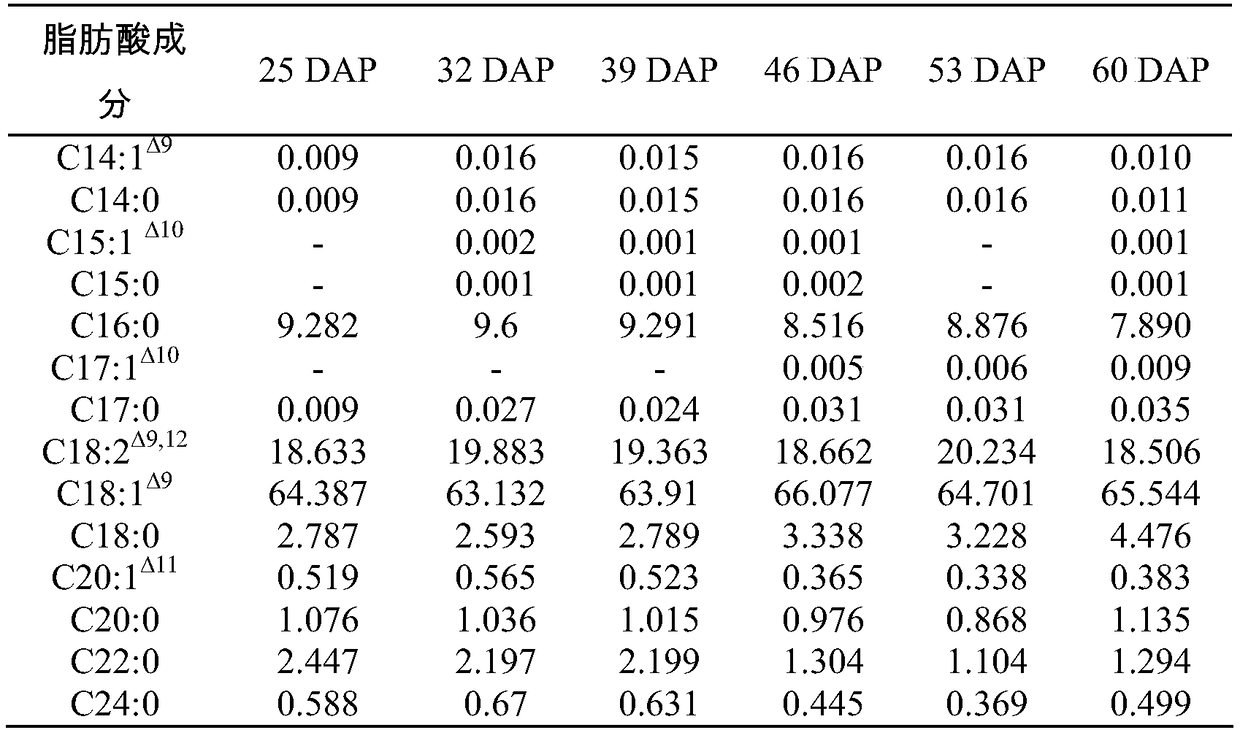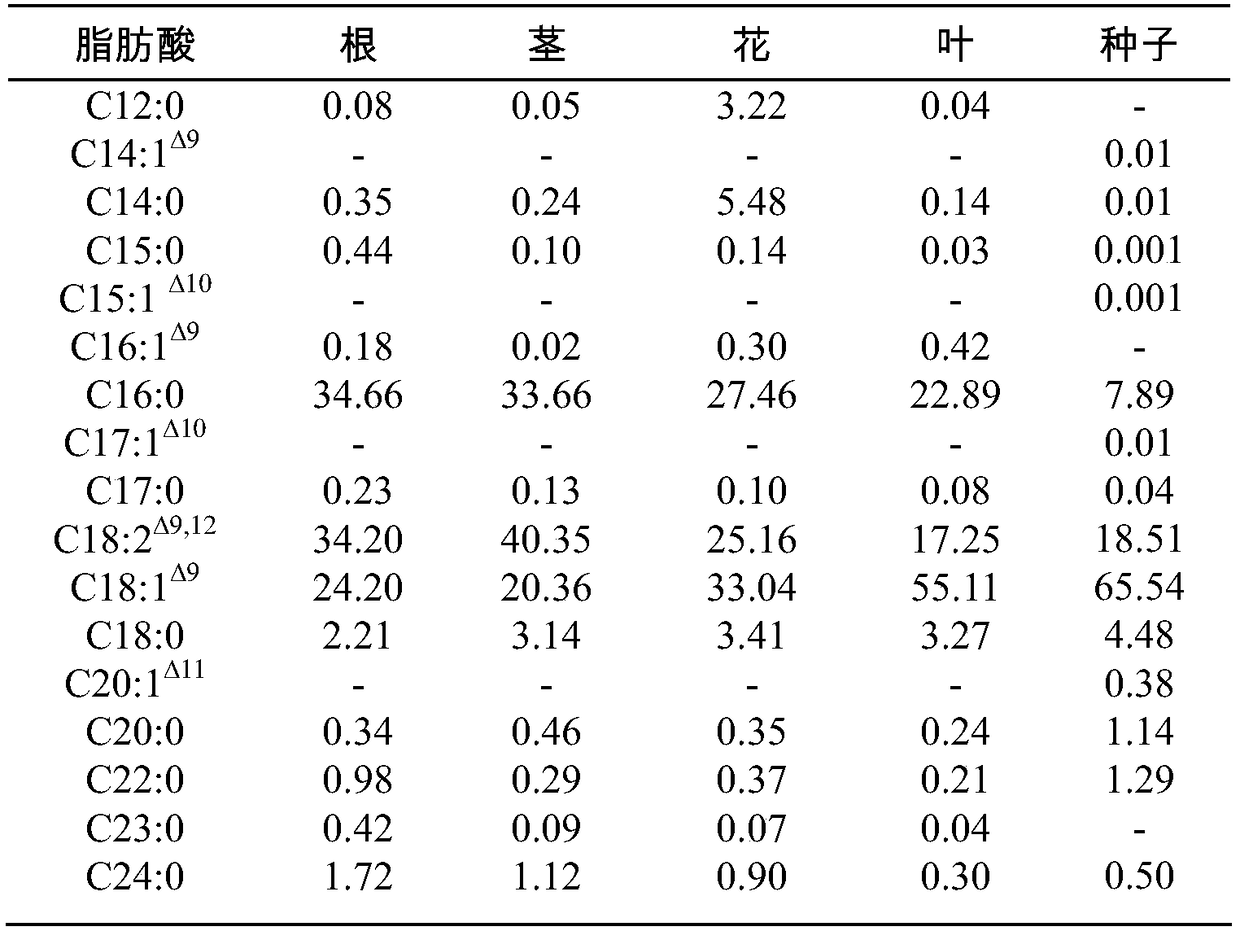A Simple Method for Extracting and Determining Peanut Fatty Acids
A fatty acid and peanut technology, which is applied in the direction of measuring devices, instruments, scientific instruments, etc., can solve the problems of harsh operating conditions and short service life
- Summary
- Abstract
- Description
- Claims
- Application Information
AI Technical Summary
Problems solved by technology
Method used
Image
Examples
Embodiment 1
[0019] Samples were taken at different stages of the seed development of the peanut variety Huayu 19, starting from 25 days after the needles went to the ground (DAP), and samples were taken every 7 days, and a total of 6 samples were taken. Peel off the husk, keep the seeds, grind repeatedly with liquid nitrogen, and then freeze-dry the ground seeds to obtain dry tissues. Use a universal balance to accurately weigh 0.01g (m) of dried peanut tissue, put it into a 5ml crimp headspace bottle that has been cleaned and dried by alcohol, add 850μl of methanol and 100μl of hydrochloric acid, and ultrasonically (300w, 28kHz) for 10min Mix well. Then 50 μl of 2,2-dimethoxypropane was added to the bottle. Use a capper to seal the headspace vial with an aluminum cap with a polytetrafluoroethylene pad, and react in a water bath at 85°C for 1 h. Oscillate once every 10 minutes during the methyl esterification process. After the reaction, take it out and cool to room temperature. After...
Embodiment 2
[0023] The peanut variety Huayu 19 was grown in a 16-hour light / 8-hour dark (28°C / 22°C) light incubator. Three kinds of peanut tissues including roots, stems and leaves were taken from three-leaf seedlings that grew two weeks after germination, and flowers were taken from peanut plants that grew about 60 days after germination. The samples were washed 3 times with sterilized distilled water, and dried tissues were obtained after freeze-drying. Accurately weigh 0.01 g (m) of dry peanut tissue with a universal balance, put it into a mortar, add liquid nitrogen and grind repeatedly to destroy the cell wall of the tissue. Add 850 μl of methanol to the mortar and transfer the tissue extract and residue thoroughly to a 5 ml crimp top headspace vial. Then add 100 μl of hydrochloric acid to the bottle, and mix with ultrasound (300w, 28kHz) for 10min. Then 50 μl of 2,2-dimethoxypropane was added to the bottle, and the headspace bottle was sealed with an aluminum cap with a polytetraf...
Embodiment 3
[0027] Prepare the internal standard stock solution first. Weigh 10 mg of internal standard nonadecanoic acid (purchased from Aladdin), accurately weigh it, place it in a 10 ml volumetric flask, add isoamyl alcohol to the mark, shake well, transfer it to a sealed screw-top test tube, and store it in cold storage. Obtain internal standard stock solution. Use a universal balance to weigh 0.01g (m) of mature air-dried seeds of wild-type Arabidopsis (Col-0), put them into a 5ml crimp-top headspace bottle that has been cleaned and dried by alcohol, and use a clean glass rod that has been cleaned. Crush the seeds. Add 850 μl of methanol and 100 μl of hydrochloric acid to the bottle, sonicate (300w, 28kHz) for 10 minutes to mix well, and rinse the glass rod. Then 50 μl of 2,2-dimethoxypropane was added to the bottle, and then 36 μl of nonadecanoic acid internal standard stock solution with a concentration of 1 mg / ml was added. Use a capper to seal the headspace vial with an alumin...
PUM
 Login to View More
Login to View More Abstract
Description
Claims
Application Information
 Login to View More
Login to View More - R&D
- Intellectual Property
- Life Sciences
- Materials
- Tech Scout
- Unparalleled Data Quality
- Higher Quality Content
- 60% Fewer Hallucinations
Browse by: Latest US Patents, China's latest patents, Technical Efficacy Thesaurus, Application Domain, Technology Topic, Popular Technical Reports.
© 2025 PatSnap. All rights reserved.Legal|Privacy policy|Modern Slavery Act Transparency Statement|Sitemap|About US| Contact US: help@patsnap.com


